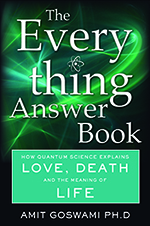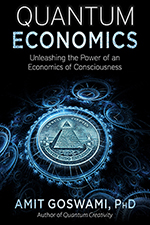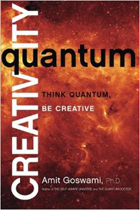Creativity and Reincarnation
By Amit Goswami, Ph.D.
Anyone can be highly creative, but the issue is nuanced. For one thing, in order for any endeavor to be successful, a high degree of motivation and strength of intention are required. How creative we are depends on how badly we want to find soul-satisfying answers to our inquiries: How strong is our need to know? Anyone can be creative, but the spectrum of creative people is vast; what factors determine our place along that spectrum? Environmental conditioning plays a role, genetics may play a limited role, synchronicities play a role, unconscious drives play a major role, and the learning we accumulate as the “soul” (the learned propensities of the subtle body) reincarnates through many lifetimes, and may be the most important factor of all.
When the material body dies, these learned tendencies of the subtle body survive as nonlocal memory, and will reincarnate in another physical body in the future. In between death and rebirth, we survive as a “quantum monad” (popularly called a “soul”), a reservoir of accumulated character aspects or propensities that Easterners describe using the Sanskrit words karma and sanskara.[1]
There is empirical evidence suggesting that memory is nonlocal. This finding supports the Vedic idea that learned memory is not only local but also nonlocal, for which the ancient term is akashic, a Sanskrit word meaning outside of space and time. Further relevant empirical evidence can be found in a phenomenon that every parent of a newborn has experienced firsthand. Babies are not born tabula rasa (an empty slate) but with already developed propensities that can be triggered.
Take the case of the East Indian mathematician Srinivasa Ramanujan, who was born into an entirely nonmathematical family, yet with almost no formal training went on to make extraordinary contributions to mathematical theory, number theory, and infinite series. Then there is the case of Mozart. His family was musical, but this could hardly explain how as a six-year-old child Wolfgang could compose original scores. To my way of thinking, these geniuses were born with an innate creativity, enhanced by motivation and an ability to focus intention that was passed on to them from their previous incarnations.
Yoga Psychology and the Concept of Mental Qualities
Reincarnation theory suggests that of all the propensities we bring from our past reincarnations the three most important are mental qualities known in Sanskrit as gunas. The first of these is tamas. Tamas, the propensity to act in accord with past conditioning, is ever present; it is a price we pay for growing up and cluttering our brain with memories. Tamas dominates early in our journey of reincarnation; only gradually, after many incarnations does this tendency give way to rajas (situational creativity) and sattva (fundamental creativity).
The Concept of Dharma
Each one of us comes to this incarnation with an agenda that Easterners call[2] dharma. To fulfill our dharma, the decree of what we need to learn in this lifetime, we bring with us propensities acquired during many past incarnations. We are not reborn with all of those propensities, however; instead, we bring the particular set that is needed to follow our dharma.
The French mathematician Évariste Galois was killed in a duel at the age of 21; but, even so, he contributed to a new field of mathematics. Young Évariste was schooled at home until age 11; then in high school he studied the great masters of mathematics and began proving mathematical theorems on his own. Most of his work was published posthumously.
What brought Galois to mathematics was a synchronistic encounter with a geometry textbook written by a gifted mathematician. Reading that textbook must have been an unusual experience for Galois, to say the least. Some creativity researchers see this as a crystallizing kind of experience in which a match is made “between a developing person and a particular field of endeavor.” From a quantum perspective, such moments are a match between one’s dharma and a particular field—literally a match made in heaven because an unconscious drive is involved.
The crystallizing experience is an intuitive awareness of having found your dharma, your way of contributing to a purposeful universe. Joseph Campbell, the famous mythologist, writer, and lecturer, coined the popular phrase “Follow your bliss.” He himself had found his bliss early in life by seeking and finding the meaning of myths that derive from the early history of humanity.
My own life-changing experience—the revelation of my dharma—took place in 1973, after having worked as an academic scientist for a decade. I was unhappy, but I did not know why. I was a speaker at a conference in nuclear physics, and when my turn came I gave what I thought was a good presentation. Nevertheless, I was not satisfied; I found myself comparing my presentation with others and feeling jealous, an emotion that persisted throughout the day.
In the evening I was at a party: lots of free food and lots of booze, along with a lot of interesting company and people to impress. But I felt more of the same jealousy. Why were people not paying attention to me, at least not enough attention to relieve my jealous feelings? I realized that I had finished an entire packet of antacid tablets, but the heartburn I was suffering from just wouldn’t quit.
Feeling desperate, I went outside. The conference was taking place on Monterey Bay in California. It was chilly, so I was alone. Suddenly, as a blast of cool sea breeze hit my face, a thought surfaced, and then repeated itself, “Why do I live this way? Why do I live this way?”
Why was I living in such a way that my professional and personal life had become so totally detached from each other? This question stayed with me, and as time went on it drove me on a quest to integrate physics with my daily life. This, in turn, led to all the things that my life became since then. I had found my dharma!
The discovery of the archetypes with which we identify (lover, mother, father, child, trickster, sage, etc.) requires fundamental creativity. Situational creativity then allows us to engage in many secondary acts of creativity based on that discovery. The more sattva, or fundamental creativity, we have in a particular life, the more we can engage directly with the great archetypes, using creativity “in the search for the soul.” If we have sattva along with rajas, or situational creativity, we complement our search for the soul by providing scaffolding for all humanity to evolve.
How do you increase your motivation to be creative? Through what the philosopher Sri Aurobindo called the purification of sattva. Initially, when your sattva is impure, tamas (conditioning) dominates, and all that comes up for unconscious processing is ego stuff and repressed images of the personal unconscious. With the purification of sattva, rajas begins to dominate, and images from the collective unconscious open to you. Only with further purification, with the development of sattva dominance, does your motivation for creativity become driven by the quantum unconscious and become pure curiosity about the archetypes; now you can delve into unconscious processing that takes you into uncharted territory.
Can anyone be creative at this level? Again the answer is yes, but it takes a number of incarnations to build the requisite experience. The fact is that at this stage of human evolution there are many immature souls for whom creativity will be difficult. If you are interested in creativity, in enhancing the role it can play in shaping your life, then you already have what it takes. Applying a quantum perspective can bring your creative genie out of the bottle.
Neuroscientists have discovered that our brain has a remarkable quality called “neuroplasticity”—the ability to lay down new networks of nerve cells to accommodate new learning, including what you learn in support of your deepest creative impulses. You initiate this process by exploring the archetypes, by tuning in to the purposeful universe, by becoming aware of the messages of synchronicity all around you, and most of all by discovering your dharma—your learning agenda.
CREDIT
© 2014 by Amit Goswami, a physicist and author of several popular books who appeared in the films What the Bleep Do We Know? and The Quantum Activist. This article is an excerpt from his recent book, Quantum Creativity: Think Quantum, Be Creative, published by Hay House, www.hayhouse.com.



